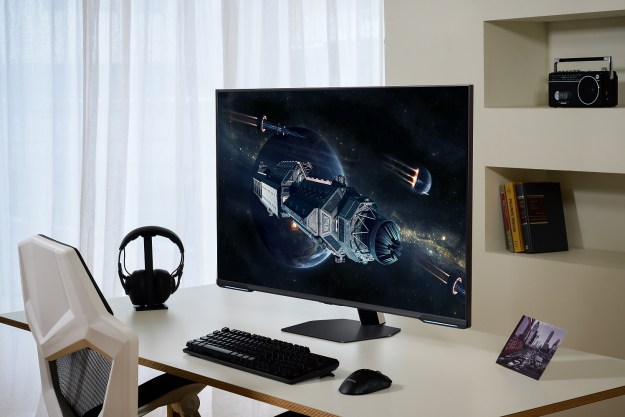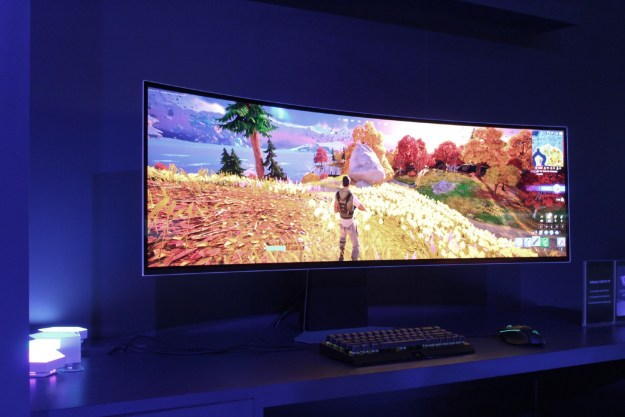Acer unveiled a number of new gaming monitors under its Predator and Nitro brands at CES 2021, bringing the standard features that PC gamers traditionally seek out: Fast refresh rates and high-resolution panels. And with the new Nitro XV282K KV monitor, Acer is also going after console gamers.
The standout feature of the 28-inch Nitro display is support for the new HDMI 2.1 standard, which makes it easy to switch between a PC gaming rig and a new console, like Microsoft’s Xbox Series X or Sony’s PlayStation 5 — provided you’re able to get your hands on any of these systems.
HDMI 2.1 is the magic port that the new consoles and next-gen televisions use, which allows gamers to play at 4K at 120Hz. The Nitro XB282K is currently the first to introduce the new port standard to a gaming monitor, whereas other monitors rely on HDMI 2.0 and DisplayPort 1.4.

In addition to supporting HDMI 2.1, the Nitro XB282K KV can also connect to PC systems via DisplayPort 1.4 or USB-C connections. This monitor features a high resolution 4K UHD resolution panel with 144Hz refresh rates and is compatible with AMD’s FreeSync, so gamers looking to upgrade to one of the new Radeon RX 6000 series cards should be able to get some smooth gameplay with this screen.
The Nitro monitor is expected to ship in May, and the panel will cost $899.
Predator XB323QK NV

Gamers who need ultra-fast refresh rates on a high-resolution panel will want to check out Acer’s Predator XB323QK NV. This panel is perfect for gamers who want to tap out the performance of their new graphics cards, like Nvidia’s GeForce RTX 3080 or RTX 3090. Equipped with Nvidia G-Sync support, the Predator XB323QK NV comes with a 32-inch IPS screen with 4K UHD resolution and 144Hz refresh rate that should provide some buttery smooth on-screen action.
Along with the requisite technical specifications for this panel, Acer is also boasting that the panel comes with additional enhancements designed to protect gamers’ eyes during long gaming sessions. Alongside Acer’s usual suite of VisionCare settings — like reducing blue light levels — the company promises that this is among the first display that gets the TUV/EyeSafe certification.
And a big part of why Acer was able to achieve EyeSafe certification is the company’s LightSense, ColorSense, and ProxiSense technologies. LightSense, as its name implies, automatically adjusts the screen’s brightness based on the available ambient lighting, while ColorSense and ProxiSense measure the ambient lighting and adjust the color temperature of the panel. And given that this panel can achieve 90% of the wide DCI-P3 color space, it should make handling the impromptu creative projects, like photo editing, easier and more accurate under various types of indoor lighting. The panel also gets VESA DisplayHDR 400 certification, so you’ll get great contrasts for darker scenes in a video game.
Along with eye comfort, Acer is focusing on ergonomics with this panel, as it ships with the company’s ErgoStand for easy swivel, pivot, and tilt adjustments, The monitor can also be raised or lowered on the stand to achieve the perfect — and most comfortable — viewing angles.
The company did not provide specifics for when the Predator will launch, but you can expect this gaming monitor in the second quarter. It is expected to cost $1,200 when it goes on sale.
Predator XB273U NX

If you need a smaller panel, Acer’s Predator XB273U NX comes with a 27-inch IPS panel with a resolution of 2,560 x 1,440 pixels. The 2K panel does not have a G-Sync module, but Acer stated that the display supports a refresh rate of up to 244Hz that can be further overclocked to 275Hz. The panel is capable of covering up to 95% of the wide DCI-P3 color space, so it can be versatile enough for gamers who need to get some creative edits done while working from home during the pandemic.
The panel is expected to ship in May for $1,099.
Editors' Recommendations
- Anything is possible in this new era of gaming monitors
- HP takes on Alienware and Samsung with its 4K QD-OLED gaming monitor
- I saw the second generation of Samsung’s QD-OLED gaming monitors
- LG’s new 480Hz gaming monitor just changed the game
- Acer’s new gaming laptop bring Nvidia RTX 40-series GPUs under $1,000


